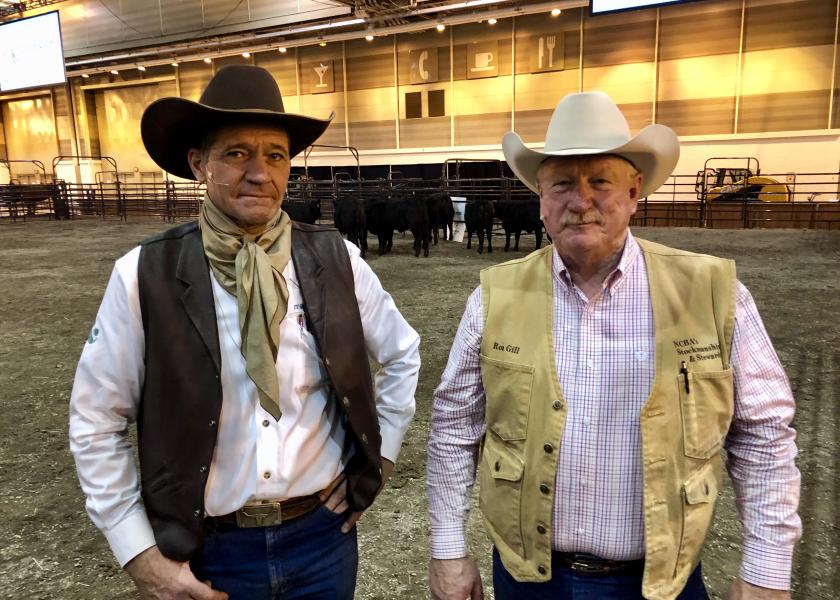You Herd Right: 8 Tips to Gather the Herd

Using the words “stubborn” and “cattle” together might be a bit redundant. But thoughtful pressure and keen cattle sense go a long way when you’re moving cattle, as stockmenship trainers Ron Gill, Ph.D, and Curt Pate demonstrated at the 2019 NCBA Cattle Convention. Gill and Pate shared advice on how to gather the herd and at the Stockmanship and Stewardship Demonstration Arena, sponsored by Merck Animal Heath.
First, an important point. Gill, a professor and Extension livestock specialist at Texas A&M University, says you’ll know your cattle and what they’re used to. While they demonstrate on foot and with horses, this doesn’t prevent you from using other methods, including ATVs or UTVs, if you take time to get your livestock used to being around this equipment. The key is how you use the tool you’ve got, he says.
Here’s a look at a few of Gill’s and Pate’s top tips we learned to move cattle.
1. Make sure no kids are left behind. Gill says you’ll make your job easier if you gather early and let the cows and calves mother up. “If you go out and start making some motion and movement around the cow, they tend to go back to the kid,” he says. These pairs need to learn that when you show up and get them to move they’re supposed to go together.
“My goal every time I gather cows and calves is to not have those calves at the back when we go through the gate. And that’s hard to do, to get those gals to keep those calves with them as we go out to pasture,” Gill says. “But when it does happen, it makes you feel pretty good.”
2. Stop those lingering looks. That heifer’s deep brown eyes and thick eyelashes sure are purty, but it’s business time and you don’t need her making eyes at you when it’s time to move. “It’s real important how you position yourself,” Pate says. “Getting that movement started and keeping that movement going is real important.” The right position and pressure keep those cattle moving and stop them from looking back at you. See this approach in action:
3. Find a leader—and change its mind. If you can get a lead cow moving in the right direction, it will drag the rest of the cattle along. Pate and Gill demonstrate how to pass change a lead cow’s mind—and how to pass the cattle back and forth with firm, gentle pressure—here:
4. Put cattle under pressure. But make sure it’s the right amount of pressure. Too much and your cattle will freak out. Too little and the job will take longer and be more difficult. “Sometimes too little pressure is the worst thing you can do,” Pate says. See Pate and Gill demonstrate appropriate pressure:
5. Draw the herd. Just as you apply appropriate pressure to gather the herd and move it in the right direction, you can draw the herd by creating the path of least resistance. Block the places where cattle might get stuck—think corners and escape routes. Open the gates you want cattle to pass through, and when cattle are moving a person at the front can lead even as the person at the back applies pressure. Pate applies pressure as Gill leads in this example.
6. Read their minds. “I’ve got to be able to read the cattle and determine what they need and don’t need,” Pate says.
7. Mind the flight zone. “The angle and the sphere of your approach matters, and it can offer way better results than coming in and just shoving,” Pate says. Remember, you’re watching for the animal’s point of balance—usually the shoulder area, depending on its wide-angle vision. Want the animal to move forward? Stand behind the point of balance. Want it to move backward? Stand in front of the point of balance. Pate demonstrates how to make a heifer turn to the left, to the right, and stop her feet.
8. Move beyond flight zone. Once you understand the principle of the flight zone, Pate says you need to move beyond it. “Think about the pressure you put on the cattle, and the response you want to get from that pressure,” he says. “How close can I get to these cattle working where they’re not afraid but they’re still working.”
Finally, remember this advice: The cow needs to be able to take your pressure but keep her mind on the path at the same time, Pate says.
Ready to learn more? The Stockmanship and Stewardship Tour will offer hands-on cattle care training across the United States in 2019. Find tour dates and locations here.
Related articles:
Quiet Power: How Ag Can Embrace Animal Welfare
Bridge the Gap Between Animal Welfare and Wellbeing







